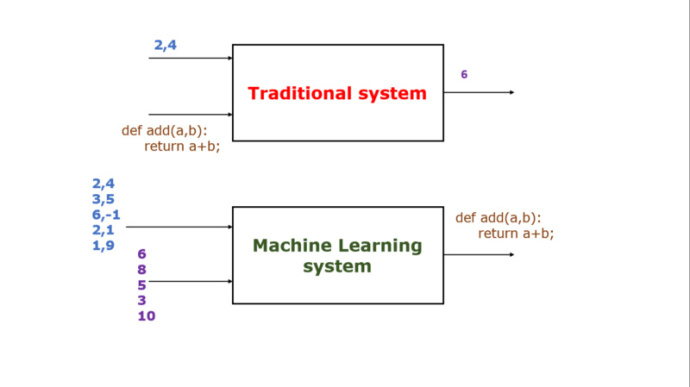Python笔记 #19# 实现bpnn
代码编辑&解释工具:Jupyter Notebook 快速入门
形象说明BP神经网络的用法(图片来自推特):

Bpnn类最主要的三个方法:
- initialize方法,用于设定神经网络的层数、各层节点数
- predict方法,方便用户应用模型做预测
- train方法,用来训练模型
所有代码如下(需要导入numpy模块):
import numpy as np
import math def linear_transformation(matrix, vector):
return vector.dot(matrix) # vector = np.array([1, 2])
# matrix = [[1, 2], [3, 4]]
# vector = linear_transformation(matrix, vector)
# print("linear_transformation:", vector)
# print("linear_transformation:", type(vector)) def active(vector, f):
return np.array(list(map(lambda x: f(x), vector))) def sigmoid(x): # 激活函数
return 1.0 / (1.0 + math.exp(-x)) # result = active(vector, sigmoid)
# print("active:", result)
# print("active:", type(result)) class Bpnn:
# model是一个list,例如[2, 2, 3, 1]表示输入结点2个,第一个隐含层有2个节点,第二个隐含层有3个节点,输出结点1个
def initialize(self, model):
# 随机生成模型对应的矩阵(网络权重)和偏置
self.matrixs = []
self.biases = []
for i in range(len(model) - 1): # 矩阵个数为总层数减1,例如4层的网络只需要3个矩阵就可以了
self.matrixs.append(np.random.randn(model[i], model[i + 1])) # 矩阵的列数是对应输入节点的个数,矩阵的行数对应输出节点的个数 for i in range(len(model) - 1):
# 列表中的每个np数组代表一整层节点的偏置
self.biases.append(np.random.randn(model[i + 1])) def predict(self, vector):
result = np.array(vector)
for i in range(len(self.matrixs)): # 其实就是对一个向量做多次线性变换
result = linear_transformation(self.matrixs[i], result) + self.biases[i]
result = active(result, sigmoid)
return result def neural_net_output(self, feature): # 记录各层的输出
result = []
output = active(linear_transformation(self.matrixs[0], np.array(feature)) + self.biases[0], sigmoid)
result.append(output)
for i in range(len(self.matrixs) - 1):
output = active(linear_transformation(self.matrixs[i + 1], output) + self.biases[i + 1], sigmoid)
result.append(output)
return result # 格式为[[代表第1层输出的向量], [代表第2层输出的向量], ...,[代表最终输出的向量]],所有向量都是一维的np.array,向量长度为该层节点数 def compute_error(self, prediction, actual): # 计算各层的误差,actual是样本标记值(期望获得的值)
result = []
prediction = prediction[:] # 后面的处理都不影响原始数组
prediction.reverse() # 转置便于处理
error = prediction[0] * (1 - prediction[0]) * (actual - prediction[0]) # 计算最终输出的误差
result.append(error)
for i in range(len(self.matrixs) - 1): # 计算每层的误差,可以通过转置矩阵计算上一层误差的一个因子
error = prediction[i + 1] * (1- prediction[i + 1]) * linear_transformation(self.matrixs[-1 - i].T, error)
result.append(error)
result.reverse()
return result # 格式为[[代表第1层输出误差的向量], [代表第2层输出误差的向量], ...,[代表最终输出误差的向量]],所有向量都是一维的np.array,向量长度为该层节点数数 def update_network(self, feature, prediction, error, LEARING_RATE):
# 更新权重(手算凑出来的计算方法↓)
temp = np.ones_like(self.matrixs[0])
temp = temp * LEARING_RATE * error[0]
temp = temp.T * np.array(feature)
temp = temp.T
self.matrixs[0] += temp;
for i in range(len(self.matrixs) - 1):
temp = np.ones_like(self.matrixs[i + 1])
temp = temp * LEARING_RATE * error[i + 1]
temp = temp.T * prediction[i]
temp = temp.T
self.matrixs[i + 1] += temp; # 更新偏置
for i in range(len(self.biases)):
self.biases[i] += LEARING_RATE * error[i] def train(self, get_batch, MAX_ITERATION, LEARING_RATE, MAX_LOSS):
loss = MAX_LOSS = abs(MAX_LOSS)
count = MAX_ITERATION
while abs(loss) >= MAX_LOSS and count > 0:
batch = get_batch()
for example in batch:
prediction = self.neural_net_output(example.feature)
error = self.compute_error(prediction, example.label)
self.update_network(example.feature, prediction, error, LEARING_RATE)
loss = abs(np.mean(error[-1])) # 取最后一次迭代最终输出的平均值作为本批次的误差
count = count - 1
print("迭代次数:", MAX_ITERATION - count)
print("误差:", loss) class LabeledExample:
def __init__(self, feature, label):
self.feature = feature
self.label = label # 训练一个类似于异或(xor)运算的函数,相同为假,相异为真
labeled_examples = [LabeledExample([0, 0], [0]), LabeledExample([0, 1], [1]), LabeledExample([1, 0], [1]), LabeledExample([1, 1], [0])] def full_batch():
return labeled_examples bpnn = Bpnn()
bpnn.initialize([2, 2, 1]) # 构造一个三层的神经网络,输入节点2个,隐含层节点2个,输出节点1个
bpnn.train(full_batch, 10000, 0.6, 0.01) # 学习因子为0.6, 最大允许误差0.01
print("输入层与隐含层权值", bpnn.matrixs[0])
print("隐含层权值与输出层权值", bpnn.matrixs[1])
print("隐含层阈值", bpnn.biases[0])
print("输出层阈值", bpnn.biases[1])
sample1 = [0.05, 0.1]
sample2 = [0.2, 0.9]
sample3 = [0.86, 0.95]
print("预测样本", sample1, "的结果是:", bpnn.predict(sample1))
print("预测样本", sample2, "的结果是:", bpnn.predict(sample2))
print("预测样本", sample3, "的结果是:", bpnn.predict(sample3))
Python笔记 #19# 实现bpnn的更多相关文章
- python笔记-19 javascript补充、web框架、django基础
一.JavaScript的补充 1 正则表达式 1.1 test的使用 test 测试是否符合条件 返回true or false 1.2 exec的使用 exec 从字符串中截取匹配的字符 1.3 ...
- python笔记19
今日内容 面向对象基本用法 好处和应用场景 面向对象的三大特性 内容详细 1.面向对象基本格式 # ###### 定义类 ###### class 类名: def 方法名(self,name): pr ...
- python笔记 - day6
python笔记 - day6 参考: http://www.cnblogs.com/wupeiqi/articles/5501365.html 大纲: 利用递归,实现阶乘: Python反射 pyt ...
- python笔记 - day5
python笔记 - day5 参考: http://www.cnblogs.com/wupeiqi/articles/5484747.html http://www.cnblogs.com/alex ...
- s21day21 python笔记
s21day21 python笔记 一.内容回顾及补充 内置函数补充 type():查看数据类型 class Foo: pass obj = Foo() if type(obj) == Foo: pr ...
- s21day19 python笔记
s21day19 python笔记 一.面向对象的基本知识 1.1 基本格式 # 定义类 class 类名: def 方法名(self,name): print(name) return 123 de ...
- s21day05 python笔记
s21day05 python笔记 一.昨日内容回顾及补充 回顾 补充 列表独有功能 extend:循环添加到一个列表中 1.users = ['张三',66],people = ['王五',99] ...
- python笔记-1(import导入、time/datetime/random/os/sys模块)
python笔记-6(import导入.time/datetime/random/os/sys模块) 一.了解模块导入的基本知识 此部分此处不展开细说import导入,仅写几个点目前的认知即可.其 ...
- python笔记(2)--字符串
一.字符串 字符串是不可变序列,具有序列的公共操作方法,具体操作见python笔记(1)--序列(列表 元组 range) 1.创建字符串 单引号:'Hello , I am Logan ! ' 双引 ...
随机推荐
- Java通过POI生成Excel
import java.io.FileOutputStream; import java.text.SimpleDateFormat; import java.util.ArrayList; impo ...
- Ext.define细节分析
自己写的其实还是不懂,再看看别人写的吧Extjs4 源码分析系列一 类的创建过程https://www.cnblogs.com/creazyguagua/p/4302864.htmlhttp://ww ...
- 原来CNN是这样提取图像特征的。。。
对于即将到来的人工智能时代,作为一个有理想有追求的程序员,不懂深度学习(Deep Learning)这个超热的领域,会不会感觉马上就out了?作为机器学习的一个分支,深度学习同样需要计算机获得强大的学 ...
- shiro loginUrl拦截无效
logUrl不拦截 或者 只跳转到/login.jsp 不跳到自己设置登录链接 在springmvc或事务那里 开启spring的显示代理(即cglib),并将shiro的安全管理器交给spring管 ...
- MACD各分时背离所对应的时间
MACD各分时背离所对应的时间 5分钟背离结构——2小时. 15分钟背离结构——一天半(6小时). 30分钟背离结构——3天(12小时). ...
- LeetCode167.两数之和II-输入有序数组
给定一个已按照升序排列 的有序数组,找到两个数使得它们相加之和等于目标数. 函数应该返回这两个下标值 index1 和 index2,其中 index1 必须小于 index2. 说明: 返回的下标值 ...
- mybatis batchinsert
<?xml version="1.0" encoding="UTF-8" ?><!DOCTYPE mapper PUBLIC "-/ ...
- word论文文献引用上标括号
参考 http://jingyan.baidu.com/article/c45ad29c310734051753e20d.html 在插入参考文献引用的尾注时,默认为上标数据且没有中括号.现在要统一加 ...
- 001- CreateProcess failed with error 216 (no message available)错误详解
问题详解 runnerw.exe: CreateProcess failed with error 216 (no message available) 看描述,创建进程失败,应该是main这个入口文 ...
- c++ 各种类型转换
1.int 2 string 法1:c++11里面的to_string #include <string> std::); //or auto s = std::to_string(); ...
